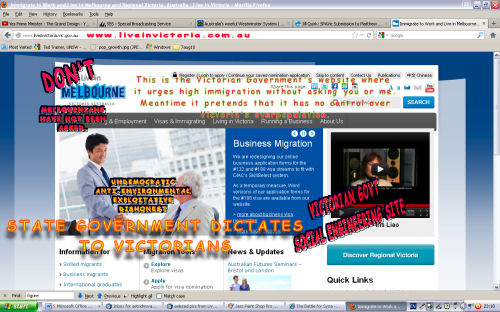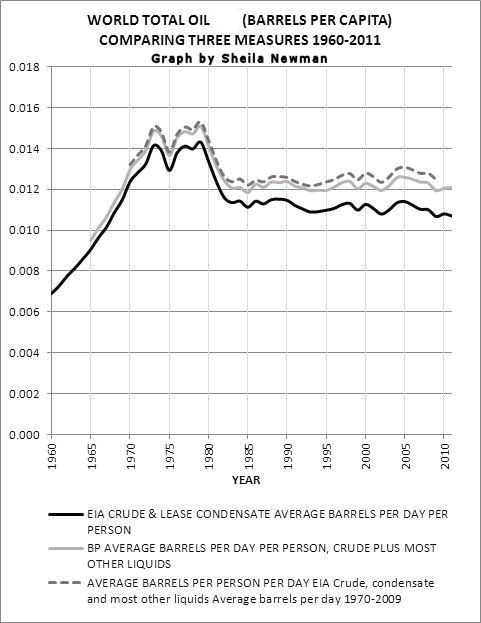Jill Quirk: SPAVic Submission to Matthew Guy on Planning Zone Reforms
 Sustainable Population Australia takes the State of the Environment report 2008 as a warning of the unsustainable path that Victoria is on as the government recklessly engineers its population at a rate about twice the level it would naturally be at present. This state government and its predecessors have actively encouraged population growth through the artificial means of seeking increasing numbers of migrants from overseas to settle in Victoria, using the website "Liveinvictoria.com.au".
Sustainable Population Australia takes the State of the Environment report 2008 as a warning of the unsustainable path that Victoria is on as the government recklessly engineers its population at a rate about twice the level it would naturally be at present. This state government and its predecessors have actively encouraged population growth through the artificial means of seeking increasing numbers of migrants from overseas to settle in Victoria, using the website "Liveinvictoria.com.au".

This submission represents the overall position of Sustainable Population Australia whose Aims and Objectives are:
- To contribute to the public awareness of the limits to Australian population growth from ecological, social and economic viewpoints.
- To promote awareness that the survival of an ecologically sustainable population depends in the long-term on its renewable resource base.
- To promote policies that will lead to the stabilisation, and then to reduction, of Australia’s population by encouraging low fertility and low migration.
- To promote urban and rural life-styles and practices that are in harmony with the realities of the Australian environment, its resource base and its biodiversity.
- To advocate low immigration rates while rejecting any selection of immigrants based on race.
- To promote policies that will lead to stabilisation, and then reduction, of global population.
There are severe constraints on the population growth patterns for the future in Australia including in the relatively environmentally hospitable state of Victoria. Sustainable Population Australia takes the State of the Environment report 2008 as a warning of the unsustainable path that Victoria is on as the government recklessly engineers its population at a rate about twice the level it would naturally be at present. This state government and its predecessors have actively encouraged population growth through the artificial means of seeking increasing numbers of migrants from overseas to settle in Victoria, using the website http://www.liveinvictoria.com.au. As we know most of those who come to Victoria gravitate to Melbourne. The State’s capital suffers from severely worsening traffic problems, demanding costly solutions, and ongoing pressure to accommodate more and more people such that agricultural land and areas of nature on the city’s fringes are constantly sacrificed. In the established areas of Melbourne and, to a lesser extent, in the regions, greater density of living is imposed on residents who are distraught to see their surroundings changed rapidly before their very eyes and to their great disadvantage.
Planning assumes change
The concept of ‘planning’ in Victoria assumes change. Most changes in building and infrastructure are driven by population growth, especially the building of more houses and roads. Planning without growth would be about improving the way things work for a given population in the face of changes over a longer time scale not associated with growth, especially those over which humans have less immediate control such as climate change. The sole objective, however, of planning today is to accommodate population growth with scant attention to residents' amenity and services.
It is clear that due to the changes to Melbourne in the last few years, residents have been aggrieved by the loss of livability of Melbourne, despite commercially defined indexes to the contrary. This loss includes loss of amenity – light space and quiet, loss of parkland, increased traffic congestion, and diminished Green Wedges. It also impacts on our democracy as authoritarian planning laws are pushed through parliament by development-sympathetic governments against widespread public objection. The schedules of the Victorian Civil and Administrative Tribunal (VCAT) have abounded with planning problems where private citizens have had to devote time, money and energy into trying to preserve their amenity or to mitigate damages impinging on them from potential developments. This type of (often futile) activity does not increase the quality of life for people; quite the opposite, in fact. It is a significant negative for them.
Residents are facing enormous loss under the now proposed planning changes. If changes are implemented, many of their cases will simply not be heard as residents lose their appeal rights. Furthermore they will not be warned about changes made in their immediate neighbourhoods. Whilst this may expedite change and create ‘certainty’ for developers, it creates helplessness and constant uncertainty for residents. People can accommodate moderate change if it is slow, but just not knowing what changes are going to occur in their neighborhoods yet to watch it happen at a rapid rate is truly unsettling. People are depressed and traumatized for a variety of associated reasons.
Planning is for the future
.
Since planning is mainly about the future the following questions should be asked in considering the proposed changes.
What path does this set us on?
Is it the path of greater livability in the sense of increasing access to nature and green spaces, with secure homes and land and quality of life? Does it have an end point? What is the likely outcome of this plan? In the already established areas of Melbourne, if we understand this correctly, proposed zones are as follows, with 3 different approaches to development applied
1. Residential growth zone
2. General Residential Zone
3. Neighbourhood Residential Zone
Where you happen to live and therefore your future or fate relies on which regime is applied to your area. As this will be a council decision it introduces a further note of uncertainty.
Putting the effect on the individual aside, the aim seems to be largely to break down barriers to change, to maximize and expedite development. Of concern is the removal of the imperative to make planning application for certain developments in certain areas. This means that they will become “as of right” and will include the extension of commercial activities into residential areas.
The aggregate effect, it seems, would be more activity and congestion and more noise, especially in areas with increasing mixed use.
Increasing densification in residential areas means diminished amenity. This might be more tolerable if the city of Melbourne were not simultaneously bulging through its previous urban growth boundary thus rapidly changing the landscape on the fringes of the city. Densification necessarily means reduction of open space especially private gardens. This reduces habitat for urban wild life, much of which is essential to our well being whether we have any conscious affection for it or not! (e.g. presence of micro bats acting as a natural and indigenous control over mosquitoes.) Loss of open space and vegetation in the established areas cities also increases Urban Heat Island Effect. This means that, even without climate change our urban areas will necessarily get hotter as vegetation is reduced and hard surfaces and masses increased. The inexorable loss of open space for children to play no doubt contributes to the much publicized childhood obesity epidemic.
No matter what measures are taken for the provision of infrastructure and services such as public transport, hospitals and schools, there is no way of catching up with these even for the existing population while there is continual extra need for the addition population built into the planning scheme.
The proposed changes to the planning scheme are more accommodating of extra population and extra activity around population centres. It is the accommodation of population that ensures that population in a given area will grow. There is no end to this process and no end envisaged in the proposed plans. This is irresponsible and negligent, considering the impacts of overpopulation are well-known. With increased densification and outward growth, quality of life in population centres, particularly in Melbourne must deteriorate.
Where does this end? It would seem that the process set in place by the proposed changes will lead ever more rapidly to increasingly overpopulated centres built to the requirements of developers, who have the economic motive of forcing more people into less space and show no signs of self-restraint.
A city such as Athens should serve as a warning to those who determine the future of Melbourne – This city grew very fast in the 1970s with high rise springing up like mushrooms bringing a 3rd world quality to the once modest sized beautiful city. It’s not too late for Melbourne. Let’s not do it!
Rural areas especially on the fringes of Melbourne
The most troubling aspect of the zoning changes is that the zones allow industry in areas where this would have been prohibited previously. The Green Wedges, set aside as the lungs of growing Melbourne 40 years ago, would no longer be safe to any degree. Once again the main concern is that there is no end to the process that these changes set up. If it were a finite number of developments and then a cap, the people of Melbourne would have some certainty that their environment will continue to be to some extent livable. But the current proposal does not mean such certainty. Instead it sets up a process whereby the Green Wedges are progressively degraded by development, thus facilitating more intensive development in the future. In effect, it ultimately annihilates them. In the shorter term this change facilitates a land-trading climate conducive to land speculation. Some will make windfall profits as land switches from rural to commercial. This will benefit the few who can take part in this game but ultimately through the rising cost of land will be detrimental to the rest of the population. It is not in the interest of the common good and quality of life for all of us.
What planning needs to be
Real Planning should take into account the physical reality of our time and place in history. It is almost without doubt that the world has passed Peak Oil production and is certainly beyond peak per capita oil production. Oil has lubricated our lives, fed us and transported us for as long as any of us can remember. As per capita production declines over the coming decades, at our peril we will build out our precious back yards and Green Wedges, extend our urban growth boundary and increase car dependency with urban settlement in previously rural areas. Our survival depends on us not doing this. The flip side of the Peak Oil coin is Climate Change and the need to limit Greenhouse Gas Emissions. Stabilising population and building in local self sufficiency and sustainable public transport is essential to this.

Figure 3, ‘World total oil per capita 1960-2011’ suggests that, where once oil came from oil wells, now, to keep up with human population growth we supplement well-oil with all kinds of other stuff, whilst still presenting it as the same old stuff. If we still relied just on crude and lease condensates from oil fields, where trends are shown by the lowest and oldest line in the graph, we would be considerably poorer in total oil supply than we seem to be. Early definitions for total world oil (see EIA Crude and lease condensate from 1960-2011) only counted crude oil and lease condensate. Coinciding with the decline in easy oil availability as it became necessary to look harder and deeper for oil, the definition of oil started to include other sources obtained away from petroleum fields. The BP definition above counts crude oil, shale oil, oil sands and NGLs (the liquid content of natural gas where this is recovered separately). The EIA definition for Crude, condensate and most other liquids from 1970-2009 comprises natural gas plant liquids, and ‘other liquids’, defined as, “Biodiesel, ethanol, liquids produced from coal and oil shale, non-oil inputs to methyl tertiary butyl ether (MTBE), Orimulsion, and other hydrocarbons.” That’s a lot of new sources, all of them requiring more energy to extract than that required to harness the traditional ‘gusher’ close to the surface, now a rare phenomenon. (Excerpt from forthcoming book, Lost Tribes, by Sheila Newman..)
Victoria needs to work within the real constraints that face us for the survival of those who are too young to take part in this submission exercise today and for their children. Changes to the Planning code need to be made with this consideration uppermost.
Wrong way- Go back-
Population restraint is about planning at the local level.
Victoria must plan to achieve a stable population not too far beyond the middle of this century to avoid a severely compromised future. This is possible and planning for it needs to start now.
The issue of zone reform is critical and the changes envisaged are so extensive in scope I would advocate that the state government set up a parliamentary enquiry to address it in detail to ensure the best possible outcome for the people of Victoria.
NOTES
The so-called “Global Livability Report” ranks Melbourne high, but it also ranks Hong Kong and Vancouver high – both of the concrete nightmares where development trumps democracy, nature and access to natural amenity. http://www.eiu.com/site_info.asp?info_name=The_Global_Liveability_Report
The 'livability index' report comes from the Economist Intelligence Unit (EIU), which is part of a group associated with the Anglo-centric Economist magazine. People in Hong Kong rent cages stacked one on top of the other in rooms in concrete high rises. There are protests about the abrogation of public land and the ever increasing intensity of development. The EIU put overcrowded concrete Vancouver and Melbourne equal at the head of its list in 2002. Clearly this list is a list about concrete spaces and developers' anti-human values and the Economist’s unwise promotion of economic growth and globalisation. The award is used as a manufactured consensus thing promoted by big business for big business and against relocalisation, human scale and natural surroundings. In other words it is corporate propaganda. About the Economist group:
"From its beginnings in 1843, when The Economist newspaper was founded by a Scottish hat manufacturer to further the cause of free trade" ... http://www.economistgroup.com/what_we_do/our_history.html"
"Many of the issues facing the world have an international if not global dimension. The Economist brand family is ideally positioned to be the commentator, interpreter and forecaster of the phenomenon of globalisation as it gathers in pace and impact." [In other words, a propaganda outfit that actually has some deluded ordinary subscribers.] http://www.economistgroup.com/what_we_do/our_brands/the_economist_brand_family/index.html
Jill Quirk:
President: Sustainable Population Australia (Victorian and Tasmanian branch)
Postal address P.O. Box 240
West Heidelberg 3081
[email protected]
0409742927

Recent comments